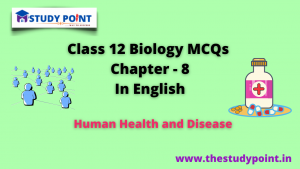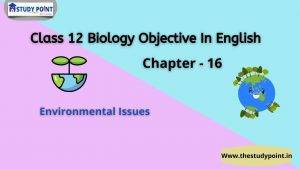Here we are providing Class 12 Biology Objective In English Chapter – 7 Genetics and Evolution include all questions presented in the Biology Class 12 books. Candidates can enlist the help of the Biology Class 12 Objective in English on the next page and gain a deeper understanding of the concepts. Class 12 Biology Objective in English Chapter – 7 Genetics and Evolution is designed by our team of subject matter experts to help students prepare for exams. English students can view the PDF of the Class 12 Biology Objective on the page below. From the Biology Book English Questions and Answers on this page, students will learn how to correctly solve problems.
Remember that the Class 12 Biology Book Objective is the best resource for a good study of the 16 chapters. Use the Class 12 Biology Book Objective as a reference and keep practicing with the answers to questions and exercises until you improve your answers to all chapters of your Class 12 Biology Program. Class 12 Biology Objective in English Chapter – 7 Genetics and Evolution will help you solve all Class 12 Biology questions chapter 1 smoothly. if you want more notes for various subject then click here
Class 12 Biology Objective In English Chapter – 7 Genetics and Evolution
1. S.L. Miller is related to
( A ) Origin & Evolution of life
( B ) Use and disuse theory of evolution
( C ) Neo-Darwinism
( D ) Neo-Lamarckism
Answer-( A )
2. Dryopithecus is more similar to
( A ) Ape
( B ) Gorilla
( C ) Chimpanzee
( D ) Man
Answer-( A )
3. Organic evolution was preceded by chemical evolution, the champions of this theory are
( A )A. I. Oparin and J.B.S. Haldane
( B ) Charles Darwin
( C ) Arrhenius
( D )Baptiste Lamarck
Answer-( A )
4. Adaptive radiation in Australian marsupials are example of :
( A ) Divergent Evolution
( B ) Convergent Evolution
( C ) Saltation
( D ) None
Answer-( A )
5. Appearance of antibiotic resistance bacteria is an example of
( A ) Adaptive radiation
( B ) Transduction
( C ) Pre-existing variation
( D ) Divergent Evolution
Answer-( A )
6. It is beleived that earth’s atmosphere before origin of life was consisted of a mixture of :
( A ) CH4, O3 , O2 , NH3
( B ) CH4,NH3, H2, H2O vapours
( C ) CH4 , NH3, CO2, H2
( D ) H2, CO2, H2O, NH2
Answer-( B )
7. The primate which existed 15 mya was
( A ) Homohabilis
( B ) Australopithecus
( C ) Ramapithecus
( D ) Homo errectus
Answer-( C )
8. Which is an example of homology ?
( A ) Eye of octopus and mammals
( B ) Wings of butterfly and birds
( C ) Flippers of penguins and dolphins
( D ) Thorns of Boughainvillea and tendrils of cucurbits
Answer-( D )
9. The brain capacity of Homo erectus was about :
( A ) 650 C.C.
( B ) 900 C.C.
( C ) 1500 C.C.
( D ) 1200 C.C.
Answer-( B )
10. The prebiotic atmosphere of earth was of a reducing nature. It was transformed into an oxidizing atmosphere of present day due to the emergence of:
( A ) Cyanobacteria
( B ) angiosperms
( C ) photosynthetic bacteria
( D) eukaryotic algae
Answer-( A )
11. Non directional alteration in Hardy-Weinberg equilibrium is :
( A ) Gene flow
( B ) Mutation
( C ) Genetic drift
( D ) Gene recombination.
Answer-( C )
12. A gene of operon which forms the repressor protein is :
( A ) Operator
( B ) Promoter
( C ) Regulator
( D ) Structural
Answer-( C )
13. Which one is linked to evolution ?
( A ) Extinction
( B ) Variation
( C ) Reproduction
( D ) Competition
Answer-( B )
14. Dodo is-
( A ) Extinct species
( B ) Endangered species
( C ) Threatened species
( D) All of these
Answer-( A )
15. The earliest hominids evolved about 4 million years ago were :
( A ) Homo erectus
( B ) Neanderthal man
( C ) Cro Magnon man
( D ) Australopithicus
Answer-( D )
16. The first cellular form of life possibly came into existence in :
( A ) 2000 million
( B ) 2000 billion
( C ) 4500 million
( D ) 4.5 billion
Answer-( A )
17. Sweet potato and Potato represent:
( A ) analogous structure
( B ) Divergent evolution
( C ) belong to same ganes
( D) both A & C
Answer-( A )
18. The extinct human ancestor who ate only fruits and hunted with stone weapons was-
( A ) Ramapithecus
( B ) Australopithecus
( C ) Dryopithecus
( D ) Homo errectus
Answer-( B )
19. The most apparent change during the evolutionary history of Homosapiens is traced in :
( A ) Loss of body hair
( B ) walking upright
( C ) shortening of jaws
( D ) remarkable increase in brain size
Answer-( D )
20. The devonian period is considered as
( A ) age of fishes
( B ) age of amphibians
( C ) age of reptiles
( D ) age of mammals
Answer-( A )
21. First life formed on earth was a
( A ) cyanobacterium
( B ) chemoheterotroph
( C ) autotroph
( D ) photoautotroph
Answer-( B )
22. The presence of gillslits in the embryo of all vertebrates, supports the theory of :
( A ) metamorphosis
( B ) biogenesis
( C ) organic evolution
( D ) recapitulation
Answer-( D )
Class 12 Biology Objective In English Chapter – 7 Genetics and Evolution
23. phenomenon of ‘industrial melanism demonstrates :
( A ) geographical isolation
( B ) reproductive isolation
( C ) natural selection
( D ) induced mutation
Answer-( C )
24. Which is not a vestigeal organ in man ?
( A ) Nictiating membrane
( B ) Tail vertebrae
( c ) Vermiform appendix
( D ) Nails
Answer-( D )
25. Major radiation of mammals, birds and pollinating insects took place in which epoch?
( A ) Oegocene
( B ) Eocene
( C ) Pliocene
( D ) Palaeocene
Answer-( D )
26. Golden age of reptiles was:
( A ) Proterozoic era
( B ) Palaeozoic era
( C ) Mesozoic era
( D ) Coenozoic era
Answer-( C )
27. Amphibians were dominant during
( A ) Carboniferous
( B ) Silurian
( C ) Ordovician
( D ) Cambrian
Answer-( A )
28. Coacervates were experimentally produced by :
( A ) Oparin and Sydney Fox
( B ) Fischer and Huxley
( C ) Jacob and Monod
( D ) Urey and Miller
Answer-( A )
29. Chance elimination of alleles from small population is :
( A ) Adaptation
( B ) Genetic drift
( C ) Speciation
( D ) Selection pressure
Answer-( B )
30. Which are immortal ?
( A ) Germ cells
( B ) Liver cells
( C ) Kidney cells
( D ) Neurons
Answer-( A )
31. Discontinuous variations are due to :
( A ) Crossing over
( B ) Mutations
( C ) Segregation of chromosomes
( D ) Independent assortment
Answer-( B )
32. Theory of chemical origin of life was proposed by :
( A ) Miller and Fox
( B ) Oparin and Haldane
( C ) Miller and Watson
( D )Watson and Melvin
Answer-( B )
33. Evolutionary history of an organism is known as:
( A ) Ontogeny
( B ) Phylogeny
( C ) Ancestry
( D ) Palaenotology
Answer-( B )
34. Which one provides most evident proof of evolution ?
( A ) Fossils
( B ) Vestigial organs
( C ) Embryo
( D ) Morphology
Answer-( A )
35. Dinosaurs were present during :
( A ) Palaeozoic
( B ) Precambrian
( C ) Coenozoic
( D) Mesozoic
Answer-( D )
Class 12 Biology Objective In English Chapter – 7 Genetics and Evolution
36.Extra terrestrial origin of life was proposed by
( A ) Catastrophism
( B ) Special creation
( C ) Panspermia
( D ) Sportaneous generation
Answer-( C )
37. Stanley Miller’s expreriment
Supports
( A ) Chemical theory
( B ) Abiogenesis
( C ) Biogenesis
( D ) Pangenesis
Answer-( A )
38. Operon model was proposed was
( A ) Watson & Crick
( B ) Nierenberg
( C ) Jacob & Monad
( D ) None of these
Answer-( C )
39. Echidna is
( A ) Connecting link
( B ) Vestigeal organ
( C ) Extinct link
( D ) None of these
Answer-( A )




